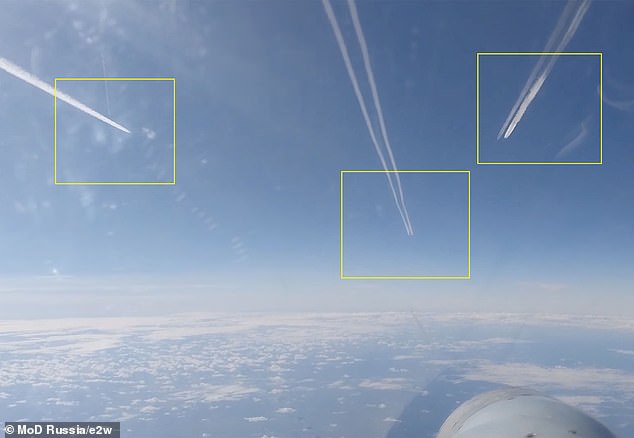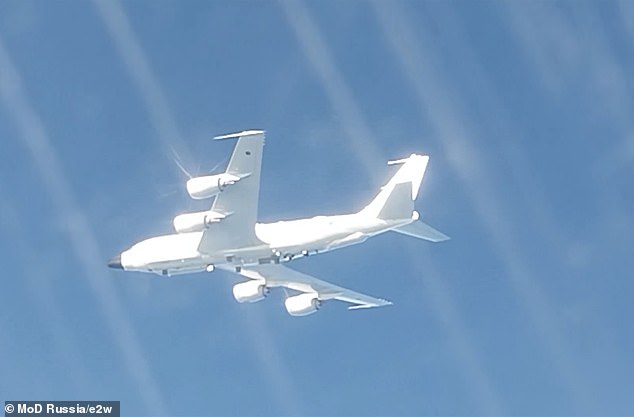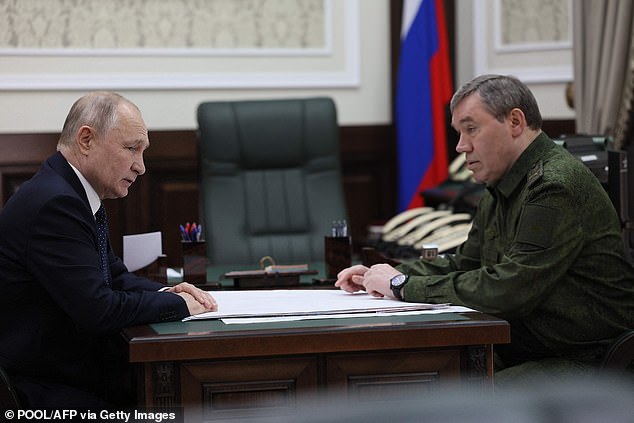Stand-off in the skies: Moment Russian SU-27 fighter jets buzz RAF spy plane and Typhoons over the Black Sea
This is the moment Russian SU-27 fighter jets flew an RAF spy plane and Typhoons over the Black Sea.
Two Russian Su-27 fighter jets were scrambled in response to the approach of the RC-135 “electronic warfare aircraft” and its escorts, Moscow said.
“A pair of Su-27 fighters of the Air Defense Force flew to identify the air targets and prevent violation of the state border of the Russian Federation,” the country’s Defense Ministry said.
“The Russian fighter crews identified the air targets as an RC-135 radio-technical reconnaissance and electronic warfare aircraft and two Typhoon multi-role fighter aircraft of the British Air Force.”
Images from the cockpit of an airplane show how the planes leave trails through the air.

Images from the cockpit of an airplane show how the planes leave trails through the air.

Two Russian Su-27 fighter jets were scrambled in response to the approach of the RC-135 “electronic warfare aircraft” and its escorts, Moscow said.
The ministry claimed: ‘As the Russian fighters approached, the foreign military aircraft made a U-turn away from the state border of the Russian Federation.’
The alleged interception of the Russian “was carried out in strict accordance with international rules on the use of airspace over neutral waters, without crossing air routes or coming dangerously close to aircraft of a foreign state.”
News agency TASS boasted that Russia’s Su-27s acted to “prevent British aircraft from crossing the state border over the Black Sea.”
Yet the statement admitted that the RAF aircraft were ‘in airspace over neutral waters’.
The footage was filmed on Thursday but released today by Vladimir Putin’s Defense Ministry.
NATO is known to be closely monitoring Russia’s hostile actions against Ukraine, much of which takes place from occupied territories in Ukraine, such as Crimea.
The incident came amid high tensions over Putin’s war in Ukraine, with the Kremlin furious over the US delivery of new long-range ATACMS weapons to Kiev.
Putin visited the headquarters of Russia’s Southern Military District, which is less than 100 kilometers from Ukraine’s southeastern border, late on Thursday.
He was informed about the war by Chief of the General Staff Valery Gerasimov, the Kremlin said.
With the extent of Western aid Kiev can expect in the future uncertain, and after a five-month Ukrainian counteroffensive that has depleted Russian reserves but apparently only damaged frontline defenses, both countries are doing their best to strengthen their to replenish stocks before 2024.

Russian President Vladimir Putin, accompanied by Army Chief of Staff Valery Gerasimov, visits the military headquarters in Rostov-on-Don that oversees the country’s military action in Ukraine, on October 19, 2023
US President Joe Biden on Friday urgently requested military aid to Ukraine and Israel in the form of a massive $106 billion national security package, but Republican paralysis in Congress means an immediate wall will be hit.
Ukraine has been issuing ammunition at a rate of more than 200,000 rounds per month, according to Jack Watling, a senior research fellow at the Royal United Services Institute think tank in London.
“There will not be enough ammunition to meet this rate of fire as NATO stockpiles are depleted and ammunition production remains too low to meet demand,” Watling wrote in a report published late Thursday.
Meanwhile, Russian production has “gone a step further,” he said.
Moscow’s domestic ammunition production is growing rapidly, with more than 100 long-range missiles produced per month, compared to 40 per month a year ago, for example, according to Watling.
Russia would also receive supplies from Iran, North Korea and other countries.
Although the counteroffensive has not made dramatic progress against the formidable Russian defenses, it has stifled the gains made by Kremlin forces.
If Ukraine can keep up the pressure, it would further expand Russia’s already strained manpower, the Institute for the Study of War said.
